What Makes Social Media Apps Successful

What Makes Social Media Apps Successful
Social media apps dominate app usage by offering a comprehensive source of online content and harnessing our desire for social validation. We surveyed 511 smartphone users to understand how people use social media apps and what features appeal to different demographics.
Frequent users of social media apps know the addictive power of these platforms – a notification alerting you to a new Snapchat or Instagram follower can immediately draw your attention, no matter what you’re doing.
It’s no surprise that social media apps dominate smartphone users’ time. Nearly 40% of smartphone owners say they frequently use social media apps. This is almost 4x more than gaming apps and communication/messaging apps, which tie for second place at 10% each.
To better understand the success of social media apps, The Manifest surveyed 511 smartphone owners who use at least 3 different apps daily to learn:
- How people are using social media apps
- Why social media apps’ features and designs keep users coming back
Our survey helps your business understand why social media apps succeed and offers advice for replicating that success in your business’s own app.
Our Findings
- Facebook is the most popular social media app by far, with 87% of social media app users checking it at least once per day.
- Millennials (53%) check Snapchat daily, nearly 3x more than Gen Xers (18%) and almost 8x more than baby boomers (7%).
- Over one-third of social media app users (35%) say they typically spend 10-20 minutes on a social media app after opening it.
- Nearly three-quarters of social media app users (72%) read or watch news stories on social media apps, confirming a significant shift in how news is consumed.
Social Media Apps Are Addicting
Social media apps are habit-forming, with the design of features, such as push notifications, feeding this addiction.
More than 30% of social media app users (34%) say they use social media apps equally throughout the day, as opposed to primarily in the morning, afternoon, or evening.

Social media apps want to keep you on the platform all day. Consider how the push notification makes you constantly aware of your life on social media, even if you aren’t actively engaging with an app at that moment.
In “The Secret Ways Social Media Is Built for Addiction,” Julian Morgans says that push notifications are similar to a “hit.”
"The vast majority of push notifications are just distractions that pull us out of the moment," he says. "They get us hooked on pulling our phones out and getting lost in a quick hit of information that could wait for later or doesn't matter at all."
Push notifications force you always to know how your friends and family are responding to your online activity.
Social media app users also tend to use an app for 10-20 minutes per session after opening it. Considering that 56% of users say they open a social media app more than 10 times per day, that adds up to a lot of time spent on social media apps.

Yet, the amount of time spent on social media apps isn’t always a fully conscious choice.
“Social-media apps plumb one of our deepest wells of motivation,” writes Ian Leslie in 1843 Magazine, published by The Economist Group.
Using social media apps can incite an actual change in your body’s chemistry.
“The human brain releases pleasurable, habit-forming chemicals in response to social interactions, even to mere simulacra of them, and the hottest triggers are other people: You and your friends or followers are constantly prompting each other to use the service for longer,” continues Leslie.
The desire to receive a “like” on your newest Facebook photo or status update gives you a rush, similar to pulling the lever on a slot machine. Will you win your followers’ attention and validation with your latest retweet of that cute cat video?
If you’re addicted to social media apps, it isn’t just you – the apps are specifically built to keep you coming back for more.
Social Media App Users Primarily Consume, Not Create, Online Content
While it may seem like people constantly publish content on social media, the posts are likely coming from a small number of prolific content creators.
When people use social media apps, over one-third say they most commonly like or favorite content.

Experts connected this finding to what is known as the “1% rule,” or “90-9-1 rule” of internet content.
“[The rule] says that 90% of the time we just consume content, 9% of the time we interact with content (like it, share it), and only 1% of the time do we actually share something,” said Sheana Ahlqvist, lead UX researcher at PhD Insights, a user research agency.
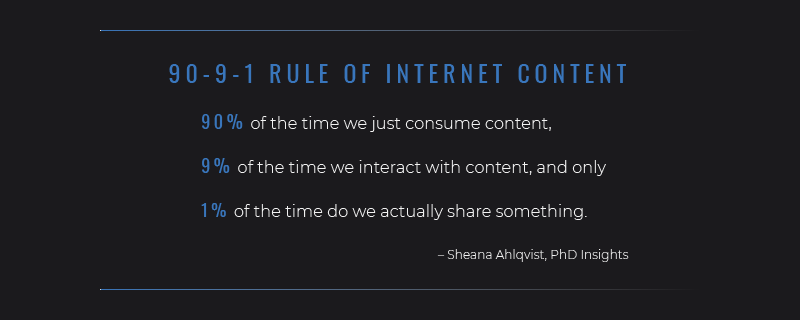
Another variation of this rule suggests that in an internet community, only 1% of users actively participate and publish content.
Liking and favoriting content is one of the easiest actions on a social media app.
“The liking and favoriting is like saying ‘bless you,’” said Alex Levin, co-founder of L+R, a Brooklyn-based creative agency. “It's a low cost, thoughtful gesture that isn't offensive.”
The more streamlined and uncontroversial an online action is, the more likely a user is to actually do it. Meanwhile, behaviors like sharing an article, image or video, or typing a public comment require greater motivation to complete.
Dr. Andrew Selepak, director of the master’s degree in social media program at the University of Florida, also compares the popularity of the “like” to a sense of “quid pro quo” – if I like your content, you’re more likely to like mine.
“Our personal, narcissistic desire to have our stuff liked often leads us to do the same for others in hope of reciprocity,” he said, “I don’t think anybody posts something to social media in hope that no one will like it.”
Josh Krakauer, founder and CEO of Sculpt, a social media marketing agency, agrees with this sentiment: “I feel like people use [the like] almost with social karma. If you like something from someone else, their likelihood of liking [your content] back increases.”
The need for social validation is persuasive and keeps you liking, favoriting, and retweeting content.
Social Media App Features Must be More Than Add-Ons
You may seek to copy other apps’ features when creating a social media app. But users don’t just want features that are added on in an attempt to keep up with the competition. They desire an authentic experience, with features that are integral to the platform.
In October 2013, Snapchat rolled out its “stories” feature, allowing users to publish temporary content, visible to their followers for only 24 hours. In August 2016, Instagram followed with its own stories feature, and Facebook joined the crowd in May 2017.
Despite joining the trend last, our survey found that Facebook’s stories feature is most popular, with 55% saying they prefer to use Facebook’s feature instead of Instagram's or Snapchat's. This result is likely skewed due to Facebook’s popularity among our respondents in general.
Krakauer says that, if you look at actual engagement with social media apps’ stories feature, then Snapchat likely dominates meaningful usage of the real-time stories feature.
“Snapchat deserves credit for the concept,” said Krakauer. “Anecdotally, what we found is that Snapchat users tend to use the feature more frequently and engage with it more often because it’s an integral part of the Snapchat experience; whereas on an app like Facebook, it truly feels like an add-on feature.”
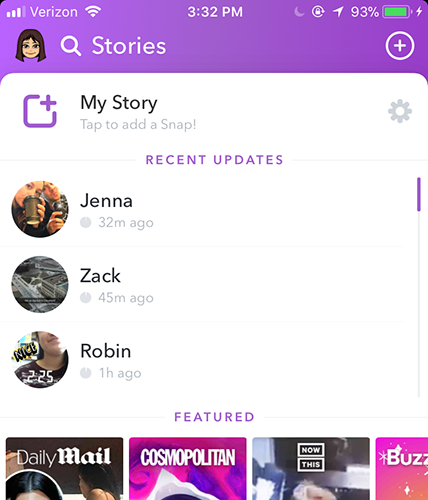
This analysis suggests that simply adding features to keep up with the competition may not create the seamless social media experience that users crave.
Facebook Rules Among Social Media Apps
In the United States, Facebook dominates among social media apps.
Nearly 90% of social media apps users check Facebook at least once per day. Instagram trails far behind in second place at 49%.
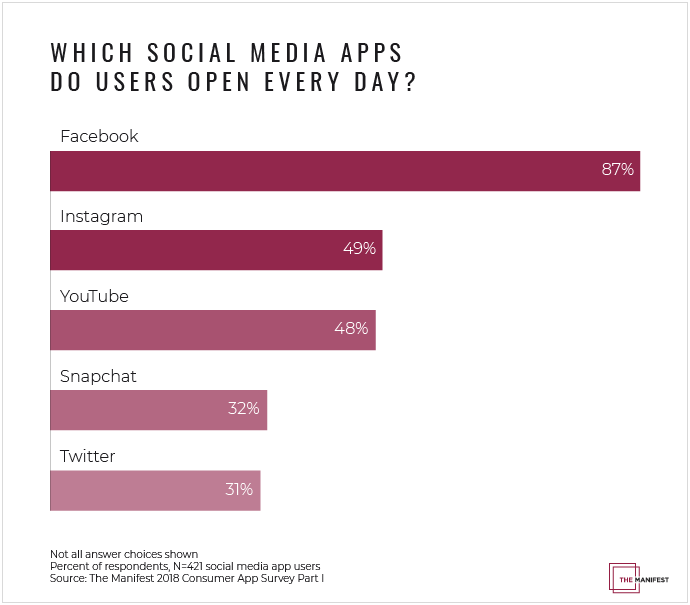
Krakauer says that Facebook became dominant by promoting a sense of universality.
“Facebook has invested considerable resources over the last 10-plus years in making an experience where everyone can find their value on the platform,” he said.
It also helps that Facebook was one of the first social media platforms to gain success and that they collect a lot of information about their users to customize their experience on Facebook.
“They’re really good at learning about their users and using that data to make a news feed of information that people find valuable,” said Krakauer. “Facebook really created the news feed, and it’s a feature that every social app in the world has come to adopt.”
Prior to its release of the news feed in 2006, Facebook simply had profiles, and you visited a specific person’s profile to view information.
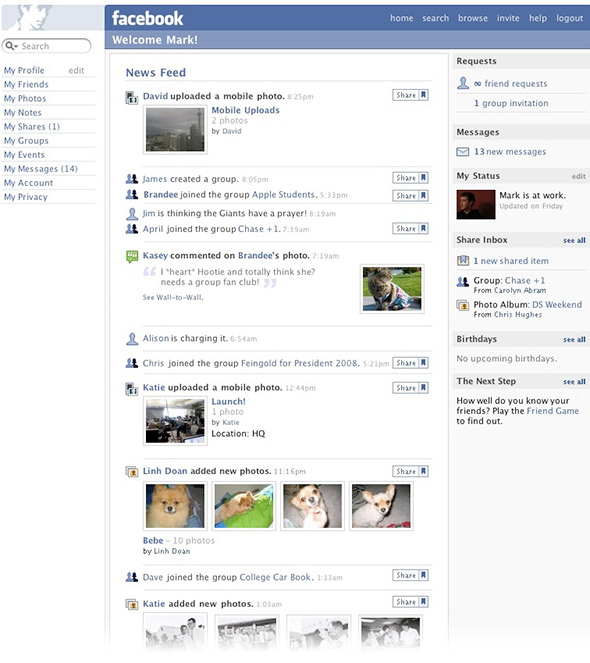
However, the release of the news feed compiled everyone’s updates into a seamless and comprehensive viewing experience.
Other apps, like Flickr and Twitter, had similar activity feeds prior to Facebook. However, Facebook’s dominance as a top social media player solidified the news feed as an integral aspect of the social media experience.
However, there are signs that younger generations may be less attached to Facebook.
Baby Boomers, Gen Xers Check Facebook More
Baby boomers and some Generation X social media app users may stick with the big-name platforms and make them work for their needs. In contrast, millennial users are more likely to jump from one social media app to another, seeking a platform that is perfectly suited for their needs, according to experts.
We found that baby boomers – categorized as respondents 55 and older – checked Facebook more frequently than Generation X (35 to 54) or millennials (18 to 34).

Levin explained that older social media app users, who did not grow up with social media platforms, may still be finding their comfort level with social media. They perhaps only joined Facebook because it is the largest and most well-known social media platform.
“The older respondents are not about to jump to the next thing in social media platforms because they're still getting their bearings on how to navigate a social network and how they can use it to their advantage," explained Levin.
If older respondents are finding it hard to adjust to a social media app, they may blame it on their own inexperience.
But, younger respondents are more likely to blame a slow learning curve on the app itself. They won’t keep using an app if it frustrates them or doesn’t fulfill their needs.
“Older users are okay with taking more time,” said Levin. “They blame themselves when they don't understand an app, whereas younger users will blame the application itself – the developer and designers – for not designing it in a way that’s intuitive for them.”
Facebook turns 18 years old in February 2018. Given its age, millennials may find that Facebook isn’t reacting well to new trends or has become too broad for their interests.
“My assumption is that Facebook is definitely on a more mature stage of the adoption or life cycle curve,” said Krakauer.
Understanding how different age groups react to social media is critical for targeting your key audience.
In contrast, the much younger Snapchat knows its key audience and is targeting them well.
Millennials Love Snapchat
Snapchat attracts millennials far more than Gen Xers or baby boomers.
Over half of millennial social media app users (53%) open Snapchat at least one time per day. This number decreases sharply for Gen Xers and baby boomers.
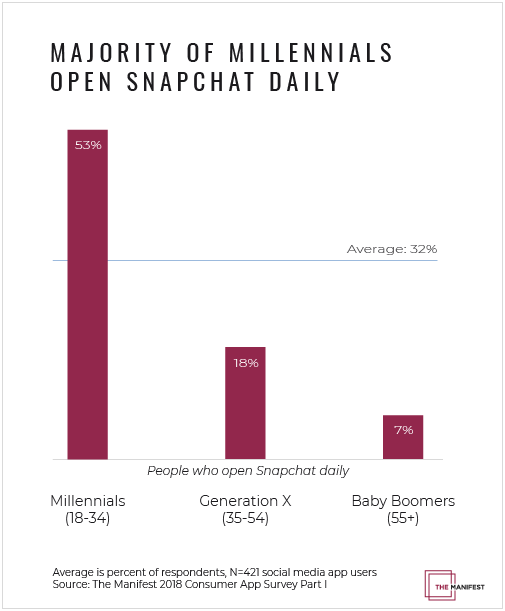
Why does Snapchat attract younger users of social media apps more than older users?
Millennials Want Personalized, On-Demand Content
Snapchat’s focus on momentary and on-demand media appeals to millennials who are used to getting the specific information they want – when they want it.
In contrast, baby boomers and Generation X may be more comfortable consuming content television-style, where the network decides what they see and when they see it.
“The older demographics are used to watching the news in the morning or evening,” said Levin of L+R. “If they called a friend and the friend didn’t answer, it was okay.”
The older demographics are used to watching the news in the morning or evening. If they called a friend and the friend didn’t answer, it was okay.
Younger generations expect personalized content on-demand.
With Snapchat, “[Millennials] can choose to tune in and out,” explained Levin. “They’re not forced to look at everybody’s information. It puts them in control of seeing it or not.”
Krakauer says Snapchat’s success among millennials also is due to its personal touch.
“One major reason why Snapchat is such a dominant force with a younger audience is that the entire experience is designed so that the camera is the communication tool,” said Krakauer. “It’s really changed how millennials communicate with each other and feels like a more personal space.”
Snapchat often doesn’t have the same emphasis on publishing refined or edited content. Instead, it offers a more stream-of-consciousness style of sharing, with users often posting quick selfies and in-the-moment videos instead of carefully filtered photographs.
“As Facebook has catered to everyone in the world, Snapchat has doubled down as being a place that still feels raw, unfiltered and personal,” said Krakauer.
Focusing the app on the individual user allows Snapchat to stand out to younger audiences that may be feeling lost in the digital deluge of social media platforms.
Snapchat Showcases the Strength of “Shareable Design”
Surprisingly, millennials may be attracted to Snapchat because its design is more complicated and less intuitive than other apps.
Snapchat’s complicated design is potentially off-putting to more mature users, said Dr. Selepak.
“I can look at my parents and see that they’ve figured out Facebook,” said Dr. Selepak. “It’s pretty user-friendly. Snapchat is not as user-friendly, which I think makes it more difficult for older people to use.”
I can look at my parents and see that they’ve figured out Facebook. It’s pretty user-friendly. Snapchat is not as user-friendly, which I think makes it more difficult for older people to use.
But younger users may enjoy learning about new app features from their friends.
In “Intuitive Design vs. Shareable Design,” Josh Elman, a partner at Greylock Partners, a Silicon Valley venture capital firm, argues that Snapchat’s popularity is an example of “shareable design,” as opposed to intuitive design.
Intuitive design allows users to learn how to use an app without instructions. The gestures and knowledge needed to operate the app are understood relatively seamlessly.
Shareable design requires users to learn by watching others. The gestures needed to access many of Snapchat’s features aren’t always obvious, but you can learn how to use them from others.
For example, Snapchat features a map where you can see friends’ locations. However, this feature requires a two-finger pinch on the camera screen – a gesture that is not clearly advertised or explained within the app itself.
Elman argues that through its lack of intuitive gestures, Snapchat turns each of its users into an evangelist for the product.
“Each of those seemingly obscure features is an opportunity for its users to show their friends how to do something cool,” he explained, “Showing your friends something cool can increase your social standing, or maybe it just gives you a good feeling.”
This good feeling equals free marketing for Snapchat.
“It’s converting you into an evangelist for its product, and you don’t even feel like you’re evangelizing: You’re just showing your friends how to do something neat,” explained Elman.
In a sense, this shareable design helps Snapchat go “viral,” especially among younger users, where an increasingly larger percentage of communication happens exclusively within social media apps.
Social Media Apps Are Go-To Source for Online Information
Social media apps give their users an endless supply of information at their fingertips. This ease of use means that social media apps aren’t just an add-on to how users consume online content, but increasingly the primary way to discover information online.
For example, consider the news. Nearly three-fourths of social media app users (72%) read or watch news stories on social media apps.
Facebook is the most popular app to consume news on by far and is nearly 6x more popular than the next app, Twitter.
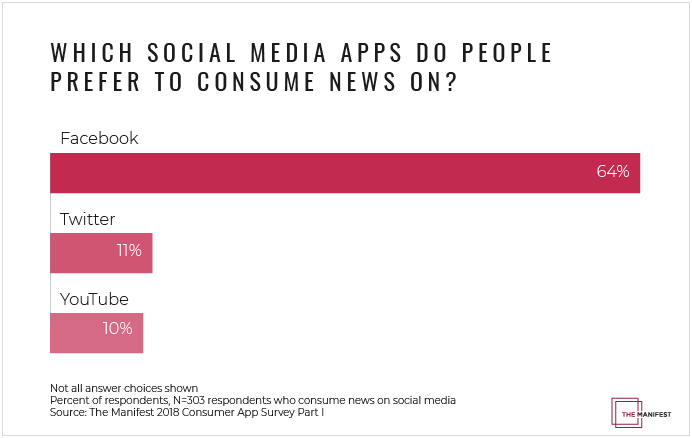
For much of its existence, Facebook’s design catered to discovering news stories.
“Facebook puts the news front and center next to your timeline,” said Dr. Selepak. “The trending stories match your interests and your location. You have already indicated to Facebook the types of stories you will click based on previous actions, so the trending news stories will be interesting and relevant to you. This creates a cycle of going back to Facebook for more of the same personally relevant stories.”
You have already indicated to Facebook the types of stories you will click. ... This creates a cycle of going back to Facebook for more of the same personally relevant stories.
In early 2018, though, Facebook announced a massive algorithm change for its news feed, emphasizing friends and family over third-party publishers.
While its unknown how this will affect Facebook’s dominance, it’s true that Facebook largely became a social media giant by positioning itself as a curator of all online content.
By publishing all types of content – from news to celebrity gossip to family photos – Facebook became central and invaluable to how users consume online media.
Users Consume News Directly on Social Media Apps
The majority of social media app users consume news directly on a social media app, instead of clicking links to third-party news websites.

These users may be watching news videos shared directly within the app or simply getting their news from headlines.
However, a recent wave of mobile-friendly formats that either publish the content directly within the app or make it feel like you are viewing the content within the app may explain this trend. These mobile-friendly formats include Facebook’s Instant Articles and Google’s Accelerated Mobile Pages.
These formats, offering stripped-down HTML, alleviate the load time to click from a social media feed to an outside article.
Page load speed is critical: 40% of users will abandon a web page if it takes more than 3 seconds to load.
Within social media apps, where the next “hit” of information is only a scroll away, it’s even more important to ensure you are fully capturing each click.
“[Social media] is basically reinforcing our need for immediate gratification and our desire for information on tap right away without too much effort,” said Krakauer. “It’s going to have tremendous and long-lasting effects for other methods of distributing information and news because people’s expectations have and will change as a result.”
Any future apps that distribute content will need to compete with social media’s ability to offer immediate gratification and a seamless viewing experience.
Social Media Apps Becoming Integral to Everyday Life
Understanding how social media apps succeed is important for any business seeking to build an app that requires user interaction.
Social media apps are ubiquitous: Our data shows that respondents use them throughout the day. However, the majority of the time app users are only consuming, liking, and favoriting content, as opposed to creating content themselves.
Social media preferences vary depending on the age of the user. Baby boomers may stick with bigger name platforms, and blame an unintuitive experience on developers. But younger users are more likely to seek out personalized and “raw” social media experiences, as evidenced by Snapchat’s overwhelming popularity among millennials.
Lastly, social media apps largely succeed because they cemented themselves as central to how we consume all types of online content, from friends' and family’s posts to the news.
While we may bemoan the increasing amount of time we spend glued to our news feeds, that trend will likely increase in the future. Social media apps are here to stay.
Social media apps' popularity may be a result of the engaging features that encourage communication and collaboration. Learn about 5 must-have social features you can incorporate into your business app to attain the same success.
About the Survey
The survey includes responses from 511 smartphone owners who use at least three different apps daily.
The respondents were primarily female (72%). Age was split among respondents: 18 to 24-years-old (15%), 25 to 34 (28%), 35 to 44 (21%), 45 to 54 (18%), 55 to 64 (12%), and 65 and over (5%).
